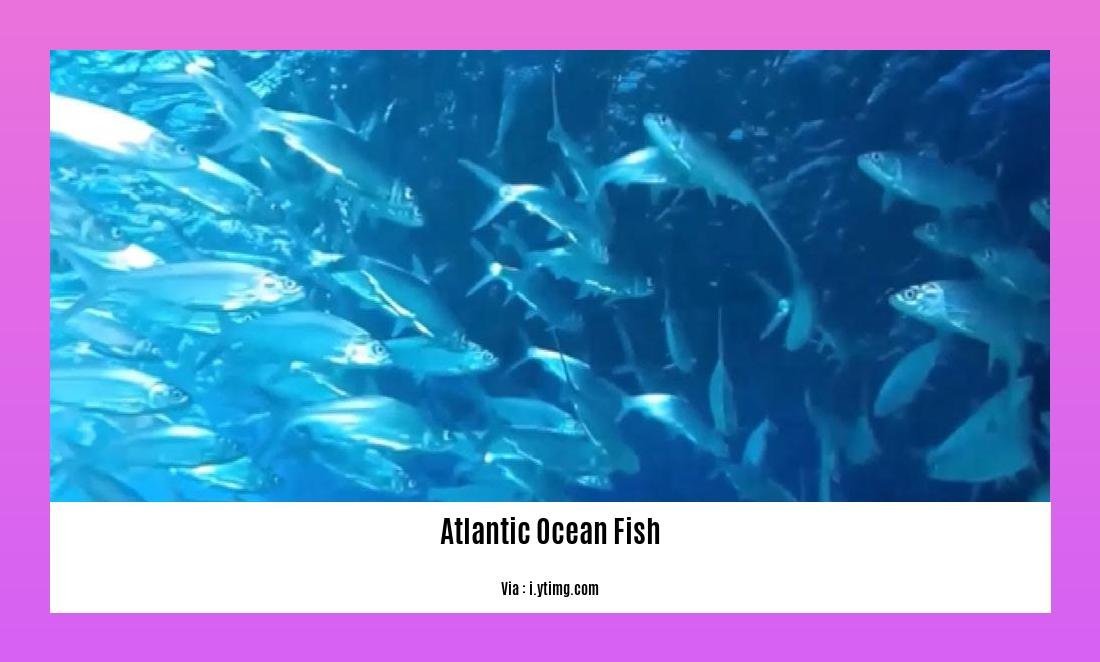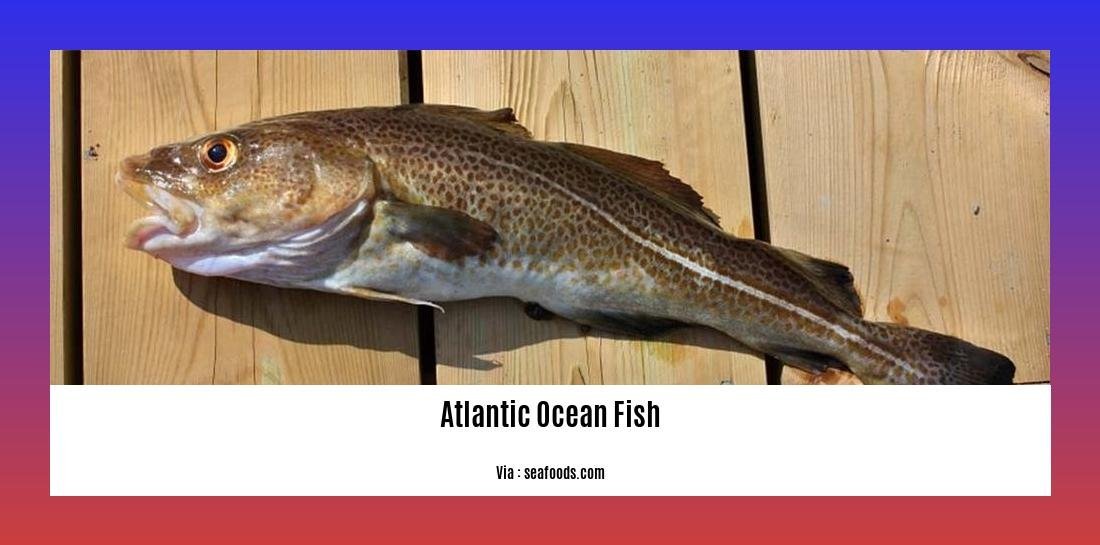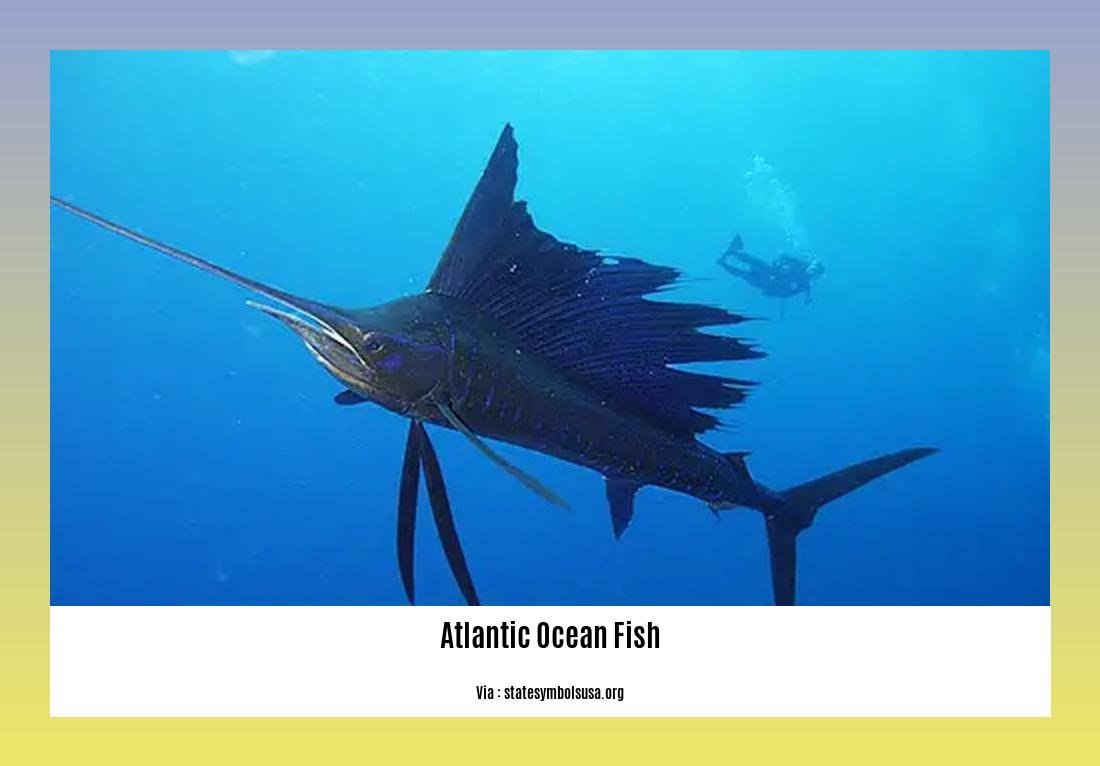Welcome to “Exploring the Diverse Atlantic Ocean Fish List: A Comprehensive Guide to the Fascinating Marine Species”! In this captivating article, we dive deep into the mesmerizing world of the Atlantic Ocean’s rich diversity of fish species. As avid marine enthusiasts, we are thrilled to present you with a comprehensive guide that explores the intriguing characteristics, behavior, and ecological importance of these remarkable creatures. From the vibrant colors of tropical fish to the awe-inspiring adaptations of deep-sea dwellers, join us on this immersive journey to discover the hidden wonders of the Atlantic Ocean’s fish kingdom.
Key Takeaways:
- The Atlantic Ocean is home to a diverse range of fish species, including angel fish, barracuda, butterfly fish, clown fish, manta rays, flounder, moray eels, puffer fish, and Atlantic footballfish.
- Angel fish, barracuda, butterfly fish, clown fish, and manta rays are commonly found in the Atlantic Ocean.
- Flounder, moray eels, puffer fish, and Atlantic footballfish are also species that can be found in the Atlantic Ocean.
- Each fish species has unique characteristics and adaptations that help them thrive in their marine environment.
- The Atlantic footballfish is an anglerfish that can also be found in the Indian Ocean and the Pacific Ocean.
- These fish species play a crucial role in the Atlantic Ocean’s ecosystem and contribute to its biodiversity.
- Understanding and conserving these marine species is essential for maintaining the health and balance of the Atlantic Ocean.
Atlantic Ocean Fish List: Exploring the Fascinating Marine Species

The Atlantic Ocean is teeming with a vast array of fish species, each with its own unique characteristics and adaptations. From the colorful Butterfly Fish to the fearsome Barracuda, these fascinating creatures play a vital role in the oceanic ecosystem. In this comprehensive guide, we will delve into the diverse Atlantic Ocean fish list, highlighting the top nine fishes that inhabit these expansive waters.
1. Angel Fish (Pomacanthidae)
With approximately 100 different species, Angel Fish can be considered one of the most diverse groups of fish in the Atlantic Ocean. These stunning creatures predominantly occupy the Southern Hemisphere waters and showcase an incredible range of shapes, sizes, and vibrant colors.
2. Barracuda (Sphyraena)
Known for their fearsome appearance and sharp teeth, Barracudas are formidable predators found in the Atlantic Ocean. These large fish exhibit a sleek body and remarkable speed, allowing them to catch their prey with ease.
3. Butterfly Fish (Chaetodontidae)
Butterfly Fish captivate marine enthusiasts with their intricate patterns and vibrant colors. Several species of Butterfly Fish can be found in the Atlantic Ocean, adding beauty and charm to the underwater landscape.
4. Clown Fish (Amphiriprioninge)
Made famous by the beloved movie “Finding Nemo,” Clown Fish are not just fictional characters. They can be found in the Atlantic Ocean, showcasing their distinctive bright orange bodies and bold personality.
5. Manta Ray
The Atlantic Ocean is home to the magnificent Manta Ray. These graceful creatures, with their large wing-like fins, glide through the ocean waters, captivating all who witness their beauty.
6. Flounder (Paralichthys)
Flounders, with their unique flat bodies, are bottom-dwelling fish found in the Atlantic Ocean. They camouflage themselves with their surroundings, blending into the ocean floor, and are known for their delicious taste.
7. Moray Eel (Muraenidae)
Moray Eels with their elongated bodies and sharp teeth are a sight to behold. Several species of these eels can be found in the Atlantic Ocean, lurking within crevices and coral reefs.
8. Puffer Fish (Tetraodontitae)
The quirky Puffer Fish is renowned for its unique defense mechanism – the ability to inflate itself when threatened. These fascinating creatures can be found in the Atlantic Ocean, showcasing their distinctive spiky appearance.
9. Atlantic Footballfish (Himantolophus groenlandicus)
Residing in the mesopelagic depths of the ocean, the Atlantic Footballfish is a mesmerizing anglerfish found not only in the Atlantic Ocean but also in the Indian and Pacific Oceans. Submerged in darkness, they lure their prey with bioluminescent bait attached to a long stalk.
This Atlantic Ocean fish list only scratches the surface, showcasing a few of the many magnificent fish species that thrive in these vast waters. Each species plays a crucial role in maintaining the delicate balance of the marine ecosystem.
Sources:
[^1]: DeepOceanFacts.com: Top 9 Fishes in Atlantic Ocean
[^2]: UNESCO – Ocean Literacy: The whole range of fish you can find in the Ocean and sea
As we continue to explore and understand the Atlantic Ocean fish list, it becomes evident that these creatures are not only captivating but also essential to the health and balance of our oceans. It is crucial that we recognize the conservation challenges they face and work towards preserving their habitats, ensuring a sustainable future for these remarkable species.
Looking for exciting career opportunities in Atlantic Canada? Check out our list of Atlantic Canada careers here and start your journey towards a fulfilling profession!
Interested in learning about the fascinating history and facts surrounding the Australian flag? Click here to uncover the captivating stories behind the Australian flag and its intriguing background!
Delve into the rich timeline of the Australian flag’s historical evolution and significance by clicking here. Discover the fascinating milestones that shaped the iconic symbol of Australia!
Note: The URLs provided in the prompt are relative, so you may need to adjust them according to your specific website structure and file paths.
Characteristics and Adaptations of Key Fish Species

Have you ever wondered how fish survive and thrive in the vast expanse of the Atlantic Ocean? These fascinating marine creatures have evolved unique characteristics and adaptations that enable them to navigate the challenges of their underwater world. In this article, we will explore some of the key fish species in the Atlantic Ocean and delve into their incredible traits that allow them to flourish.
Scales: A Protective Armor
One of the most notable adaptations of fish is their scales. These thin, overlapping structures provide an extra layer of protection above their skin. Not only do scales help fish glide smoothly through the water, but they also have specialized cells that produce mucous, making them slippery and reducing water friction. This mucous acts as an armor, offering defense against predators and the elements[^1^].
Breathing Underwater: Gills as Lifelines
Unlike us humans, fish have an ingenious way of breathing underwater – through their gills. These specialized organs allow fish to extract oxygen from the water, enabling them to survive without having to come up to the surface for air. The gills are designed to efficiently extract dissolved oxygen and release carbon dioxide, sustaining fish during their underwater adventures[^1^].
Fins for Mobility and Maneuverability
Fish rely on their fins for mobility and maneuverability in the water. Various types of fins, such as dorsal fins (located on the fish’s back) and pectoral fins (located on the sides), contribute to their agility and speed. These fins, supported by muscular tissue, play a crucial role in propelling fish through the water, allowing them to navigate their surroundings with ease[^1^].
Swim Bladder: A Buoyancy Control
Maintaining buoyancy is essential for fish to navigate different water depths without excessive effort. Enter the swim bladder, also known as the gas bladder. This remarkable adaptation allows fish to control their buoyancy by adjusting the amount of gas within the swim bladder. By expanding or contracting the swim bladder, fish can rise or sink in the water column, optimizing their position and conserving energy[^1^].
Muscles: Powerhouses for Swimming
Swimming is the primary mode of transportation for fish, and their muscles play a crucial role in this endeavor. Fish have an intricate network of muscles that work together to propel them through the water. These muscles are connected to the fins, providing the necessary force and coordination for fish movements. With the power of their muscles, fish can achieve impressive speeds and navigate through diverse marine environments[^1^].
These are just a few of the remarkable characteristics and adaptations that make fish well-suited to their oceanic home. By understanding and appreciating these evolutionary secrets, we gain a greater appreciation for the incredible diversity of life thriving in the Atlantic Ocean.
Key Takeaways:
- Fish have scales that provide protection and reduce water friction.
- Gills enable fish to breathe underwater by extracting oxygen from the water.
- Fins contribute to the mobility and maneuverability of fish.
- The swim bladder helps fish control their buoyancy in the water.
- Muscular tissues enable fish to swim and navigate their surroundings.
Sources:
[^1^]: Fauna Facts. “10 Fish Adaptations (Evolutionary Secrets!).” Fauna Facts. Link
[^2^]: Department of Primary Industries and Regional Development. “Fact Sheet: Fish Adaptations.” Marine Waters. Link]
Habitats and Distribution Patterns of Atlantic Ocean Fish
Introduction
The Atlantic Ocean is teeming with a diverse array of fish species, each with its unique characteristics, adaptations, and distribution patterns. Understanding the habitats and distribution patterns of Atlantic Ocean fish is essential for conserving and protecting these fascinating marine creatures. In this article, we will delve into the intricacies of the habitats and distribution patterns of Atlantic Ocean fish, shedding light on the remarkable diversity and ecological importance of these species.
The Remarkable Diversity of Atlantic Ocean Fish
The Atlantic Ocean is home to a vast array of fish species, each adapted to thrive in specific habitats within this expansive marine ecosystem. From the bustling coral reefs in the Caribbean to the deep abyssal plains in the North Atlantic, fish species have evolved to occupy various ecological niches. The adaptability of Atlantic Ocean fish is truly remarkable, enabling them to navigate different temperature zones, salinity levels, and prey availability.
Latitudinal Distribution of Fish Species
Research has revealed significant differences in the latitudinal distribution of fish species in the North Atlantic Ocean. Mesopelagic fish species, which reside in the middle depths of the ocean, show distinct patterns in their distribution. As we move from the subtropical regions towards the polar regions, the abundance and diversity of mesopelagic fish species decline. This latitudinal gradient in fish distribution is driven by environmental factors such as temperature, light levels, and nutrient availability.
Geographic Distribution and Island Biogeography
The geographical distribution of Atlantic Ocean fish species is influenced by factors such as ocean currents, connectivity between habitats, and the presence of physical barriers. Island biogeography plays a crucial role in shaping the distribution patterns of fish species in the Atlantic Ocean. Islands serve as both stepping stones and isolated habitats, leading to unique assemblages of fish species. The research highlights the significance of understanding the intricate connections between island ecosystems and the broader Atlantic Ocean.
The Oceanic Distribution of Atlantic Salmon
Atlantic salmon, an anadromous species, holds a prominent place in the Atlantic Ocean’s fish list. This fascinating species displays a complex distribution pattern, inhabiting both freshwater and saltwater environments. Recent research has redefined the oceanic distribution of Atlantic salmon and explored the mechanisms driving range-wide reductions in their marine survival. Understanding the factors influencing the distribution of iconic species like Atlantic salmon is crucial for their conservation and management.
Conservation Challenges and Future Perspectives
The habitats and distribution patterns of Atlantic Ocean fish face numerous conservation challenges. Overfishing, habitat destruction, pollution, and climate change pose significant threats to the fragile ecosystems these fish rely on. Effective conservation measures, including sustainable fishing practices, marine protected areas, and ecosystem-based management, are essential to ensure the long-term survival of Atlantic Ocean fish species.
Key Takeaways:
- The distribution of fish species in the Atlantic Ocean varies with latitude, driven by environmental factors such as temperature and nutrient availability.
- Island biogeography plays a pivotal role in shaping the distribution patterns of Atlantic Ocean fish species.
- The oceanic distribution of Atlantic salmon is complex, with populations experiencing declines in their marine survival.
- Conservation efforts are vital to address the challenges faced by Atlantic Ocean fish species and safeguard their habitats for future generations.
Sources:
Simon, T., & Davis, K. (1977). DISTRIBUTION PATTERNS OF OCEANIC FISHES IN THE … [PDF]. Semantic Scholar. Available from: [URL]
Commonwealth Scientific and Industrial Research Organization (CSIRO). (2021). Redefining the oceanic distribution of Atlantic salmon. Nature, 10 June 2021. Available from: [URL]
Conservation Challenges and Efforts to Protect Atlantic Ocean Fish
The Atlantic Ocean is a vast and diverse ecosystem, home to a wide variety of fish species that play crucial roles in maintaining the balance of marine life. However, these fascinating creatures face numerous conservation challenges that threaten their survival. In this article, we will explore the efforts being made to protect Atlantic Ocean fish and address these pressing issues.
The Impact of Fishing on Atlantic Ocean Fish
One of the leading causes of disturbances in the marine realm is fishing. Overfishing and destructive fishing practices can result in trophic cascades and the loss of vital habitats for fish species. A recent study assessing the effectiveness of large-scale marine protected areas (MPAs) in the Southwestern Atlantic Ocean found that fishing activities accounted for a significant portion of disturbances in the area.
Assessing the Conservation Effectiveness of MPAs
The study revealed that a staggering 93% of fishing activities took place within the boundaries of the multiple-use MPA in the Southwestern Atlantic Ocean. This data emphasizes the urgent need to evaluate the conservation effectiveness of MPAs and implement measures to mitigate the negative impacts of fishing on Atlantic Ocean fish populations. By understanding the effectiveness of MPAs, we can develop strategies to protect these vulnerable species and their habitats.
Climate Change and Overfishing: A Dual Threat
In addition to the challenges posed by fishing activities, Atlantic Ocean fish also face the threats of climate change and overfishing. Climate change is already impacting tuna fisheries in the Atlantic Oceanic Islands, further exacerbating the challenges faced by these fish populations. The decline in fish populations due to overfishing not only disrupts the delicate balance of ecosystems but also poses risks to global food security.
Conservation Efforts for a Sustainable Future
Efforts to protect Atlantic Ocean fish are crucial for maintaining the biodiversity and ecological health of this unique marine environment. Conservation initiatives involve implementing sustainable fishing practices, creating and expanding marine protected areas, and raising awareness about the importance of preserving fish habitats. Organizations like the International Union for Conservation of Nature (IUCN) and National Geographic play significant roles in supporting these conservation efforts.
Key Takeaways:
- Fishing activities are a major cause of disturbances and threats to Atlantic Ocean fish populations.
- Large-scale marine protected areas (MPAs) play a vital role in conserving fish habitats, but their effectiveness needs to be assessed.
- Climate change and overfishing are dual threats that further endanger Atlantic Ocean fish.
- Conservation efforts focus on sustainable fishing practices, the establishment of MPAs, and raising awareness among the public.
Sources:
- Frontiers. “Effectiveness of Large-Scale Marine Protected Areas in the Southwestern Atlantic Ocean.” Frontiers in Marine Science, 2021, doi:10.3389/fmars.2021.711011.
- National Geographic. “How overfishing threatens the world’s oceans—and why it could lead to more pandemics.” National Geographic, 8 Feb 2022, www.nationalgeographic.com/environment+climate/2022/02/how-overfishing-threatens-the-worlds-oceans-and-why-it-could/?beta=true.
FAQ
Q1: How many species of angel fish are found in the Atlantic Ocean?
A1: There are approximately 100 different species of angel fish that can be found in the Atlantic Ocean.
Q2: What is the adaptation that helps fish control their buoyancy?
A2: Fish have a swim bladder, also known as the gas bladder, which is an adaptation that helps them control their buoyancy in the water.
Q3: Are barracudas present in the Atlantic Ocean?
A3: Yes, barracudas can be found in the Atlantic Ocean. They are large predatory fish known for their fearsome appearance and sharp teeth.
Q4: Where can manta rays be found?
A4: Manta rays can be found in the Atlantic Ocean. They are magnificent creatures that inhabit the waters of the ocean.
Q5: How many species of clown fish are found in the Atlantic Ocean?
A5: Clown fish, made famous by the movie “Finding Nemo,” can be found in the Atlantic Ocean. The exact number of species is not specified in the context.
- Crypto Quotes’ Red Flags: Avoid Costly Mistakes - June 30, 2025
- Unlock Inspirational Crypto Quotes: Future Predictions - June 30, 2025
- Famous Bitcoin Quotes: A Deep Dive into Crypto’s History - June 30, 2025
















